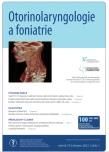The classification of tympanomastoid surgery for cholesteatoma by the new SAMEO-ATO system in clinical practice
Authors:
Homoláč M. 1; T. Valenta 1
; Školoudík L. 1,2; Mejzlík J. 1,2; Chrobok V. 1,2
Authors‘ workplace:
Klinika otorinolaryngologie a chirurgie hlavy a krku, FN Hradec Králové
1; Lékařská fakulta UK v Hradci Králové
2
Published in:
Otorinolaryngol Foniatr, 70, 2021, No. 1, pp. 15-21.
Category:
Original Article
doi:
https://doi.org/10.48095/ccorl202115
Overview
Introduction: The SAMEO-ATO system established by IOOG consensus in 2018 introduces a new, complex, and unified classification of middle ear surgery. This system is generally suitable for various surgical procedures in the middle ear. The main goal of this work is to present our experience of using the new classification system in the clinical practice focusing on cholesteatoma surgery. Methods: We have retrospectively classified the group of patients who underwent surgery for chronic otitis media with cholesteatoma between 2013 and 2017. Results: We classified 142 cholesteatoma surgeries carried out on 104 patients (56 men and 48 women at the age 5–77 years, with the mean 33 years and the median 27 years) using the SAMEO-ATO classification. There were 77 primary surgeries (S1), 40 second-look surgeries (S2p) and 25 secondary surgeries for recidivism (S2r). There was a 50% (20) incidence of recurrent cholesteatoma in S2p surgeries and 76% (19) incidence of residual cholesteatoma in S2r. We have further evaluated our group of patients by each SAMEO-ATO subclassification. In the mastoid part of surgery (parameter “M”), the combination of M1a + 2a (N = 49, 34.51%) was most frequent, followed by M2c (N = 25, 17.61%), M2a (N = 20, 14.08%), M1a (N = 4, 2.82%), M2b (N = 5, 3.52%), M3a (N = 3, 2.11%) and M3b (N = 1, 0.70%). In the ossicular reconstruction (parameter “O”), the most frequent was Osd (N = 58, 40.85%), followed by Ost (N = 21, 14.79%), Oft (N = 19, 13.38%), Ofd (N = 5, 3.52%) and Osm (N = 5, 3.52%). Conclusions: The SAMEO-ATO classifies various surgical techniques of cholesteatoma removal as well as reconstruction of the ossicular chain. It allows the creation of a unified database of patients who underwent middle ear surgery and the comparison of the results of different surgery techniques among various departments. The collected data are applicable for research purposes.
Keywords:
cholesteatoma – SAMEO-ATO – classification – surgery – Middle ear – second look – recidivism
Sources
1. Olszewska E, Rutkowska J, Ozgirgin N. Consensus-Based Recommendations on the Definition and Classification of Cholesteatoma. J Int Adv Otol 2015; 11(1): 81–87. Doi: 10.5152/ iao.2015.1206.
2. Tono T, Sakagami M, Kojima H et al. Staging and classification criteria for middle ear cholesteatoma proposed by the Japan Otological Society. Auris Nasus Larynx 2017; 44(2): 135–140. Doi: 10.1016/ j.anl.2016.06.012.
3. Yamamoto Y. Current state of usage of the Classification and Staging System of Cholesteatoma proposed by the Japan Otological Society. Otol Jpn 2015; 25(2): 160–163. Doi: 10.11289/ otoljpn.25.160.
4. Yung M, Tono T, Olszewska E et al. EAONO/ JOS Joint Consensus Statements on the Definitions, Classification and Staging of Middle Ear Cholesteatoma. J Int Adv Otol 2017; 13(1): 1–8. Doi: 10.5152/ iao.2017.3363.
5. Chrobok V, Pellant A, Meloun M et al. Prognostické faktory chronického středoušního zánětu 1. část – předoperační faktory. Otorinolaryngol Foniatr 2007; 56(4): 195–207.
6. Chrobok V, Pellant A, Meloun M et al. Prognostické faktory chronického středoušního zánětu 2. část – způsob chirurgické léčby. Otorinolaryngol Foniatr 2007; 56(4): 208–219.
7. Chrobok V, Pellant A, Meloun M et al. Prognostické faktory chronického středoušního zánětu 3. část – pooperační faktory. Otorinolaryngol Foniatr 2008; 57(1): 3–15.
8. Yung M, James A, Merkus P et al. International Otology Outcome Group and the International Consensus on the Categorization of Tympanomastoid Surgery. J Int Adv Otol 2018; 14(2): 216–226. Doi: 10.5152/ iao.2018.5553.
9. Chrobok V, Pellant A, Profant M. Cholesteatom spánkové kosti. Havlíčkův Brod: Tobiáš; 2008.
10. Merkus P, Kemp P, Ziylan F et al. Classifications of mastoid and middle ear surgery: a scoping review. J Int Adv Otol 2018; 14(2): 227–232. Doi: 10.5152/ iao.2018.5570.
11. Humphrey-Murto S, Varpio L, Wood TJ et al. The use of the delphi and other consensus group methods in medical education research: a review. Acad Med 2017; 92(10): 1491–1498. Doi: 10.1097/ ACM.0000000000001812.
12. Školoudík L, Formánek M, Chrobok V et al. Sluchová trubice. Havlíčkův Brod: Tobiáš; 2019.
13. Skoloudik L, Kalfert D, Zborayova K et al. Autoclaving of the middle ear ossicles in an animal experimental model. Acta Otolaryngol 2013; 133(12): 1273–1277. Doi: 10.3109/ 00016489.2013.825378.
14. Skoloudik L, Vokurka J, Simakova E. Mechanical treatment and autoclaving of middle ear ossicles from cholesteatomatous ears. Cent Eur J Med 2012; 7(2): 194–197. Doi: 10.2478/ s11536-011-0140-z.
Labels
Audiology Paediatric ENT ENT (Otorhinolaryngology)Article was published in
Otorhinolaryngology and Phoniatrics

2021 Issue 1
Most read in this issue
-
Stickler syndrome in the Czech Republic:
phenotypic variability and genetic heterogeneity -
Kikuchiho-Fujimotova choroba
(histiocytárna nekrotizujúca lymfadenitída) - Temporal bone meningioma
- The classification of tympanomastoid surgery for cholesteatoma by the new SAMEO-ATO system in clinical practice
